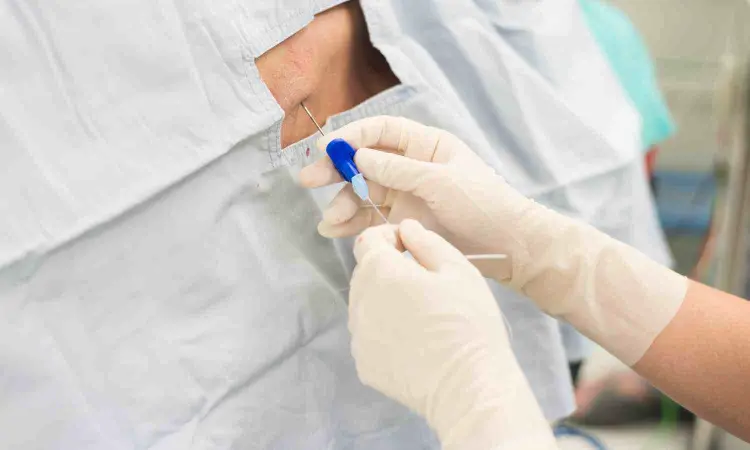- Home
- Medical news & Guidelines
- Anesthesiology
- Cardiology and CTVS
- Critical Care
- Dentistry
- Dermatology
- Diabetes and Endocrinology
- ENT
- Gastroenterology
- Medicine
- Nephrology
- Neurology
- Obstretics-Gynaecology
- Oncology
- Ophthalmology
- Orthopaedics
- Pediatrics-Neonatology
- Psychiatry
- Pulmonology
- Radiology
- Surgery
- Urology
- Laboratory Medicine
- Diet
- Nursing
- Paramedical
- Physiotherapy
- Health news
- Fact Check
- Bone Health Fact Check
- Brain Health Fact Check
- Cancer Related Fact Check
- Child Care Fact Check
- Dental and oral health fact check
- Diabetes and metabolic health fact check
- Diet and Nutrition Fact Check
- Eye and ENT Care Fact Check
- Fitness fact check
- Gut health fact check
- Heart health fact check
- Kidney health fact check
- Medical education fact check
- Men's health fact check
- Respiratory fact check
- Skin and hair care fact check
- Vaccine and Immunization fact check
- Women's health fact check
- AYUSH
- State News
- Andaman and Nicobar Islands
- Andhra Pradesh
- Arunachal Pradesh
- Assam
- Bihar
- Chandigarh
- Chattisgarh
- Dadra and Nagar Haveli
- Daman and Diu
- Delhi
- Goa
- Gujarat
- Haryana
- Himachal Pradesh
- Jammu & Kashmir
- Jharkhand
- Karnataka
- Kerala
- Ladakh
- Lakshadweep
- Madhya Pradesh
- Maharashtra
- Manipur
- Meghalaya
- Mizoram
- Nagaland
- Odisha
- Puducherry
- Punjab
- Rajasthan
- Sikkim
- Tamil Nadu
- Telangana
- Tripura
- Uttar Pradesh
- Uttrakhand
- West Bengal
- Medical Education
- Industry
Study predicts clinical entrance location for thoracic epidural catheter insertion in paramedian route

Recent research paper investigates the preferred skin puncture point for mid-thoracic epidural insertion. The primary objective of the study was to find the skin puncture point with the highest success rate for epidural catheterization, and the secondary objectives were to study the number of attempts, passes, and failure rates.
Approach and Anatomical Landmarks -
The study was conducted with 155 patients undergoing general anesthesia with epidural analgesia in the mid-thoracic region (T5-T8). A paramedian approach was used for epidural insertion in all patients. The researchers recorded the anatomical landmark used (superior or inferior tip of spinous process or interspinous cleft), the paramedian distance of the puncture point, and the number of passes required to locate the epidural space.
Success Rate and Factors -
The results showed that the success rate at different skin puncture sites was not statistically significant. The overall success rate for epidural catheter insertion in the mid-thoracic space was 84.5%, with a failure rate of 12.9%. The first attempt success rate was 49%. The success rate was not significantly different based on the distance from the midline (0.5-1 cm, 1-2 cm, or more than 2 cm) or the anatomical landmark used.
Age and Other Factors -
The study found that failed epidural catheterization was significantly higher in the age group above 56 years. However, the effect of factors such as sex, BMI, and quality of anatomical landmarks on epidural outcome was not statistically significant.
Conclusion -
The authors conclude that there is no single preferred skin puncture point or paramedian distance that is associated with a significantly higher success rate for mid-thoracic epidural insertion using the paramedian approach. They suggest that the use of ultrasound or other imaging modalities may improve the success rates, and they have initiated a randomized trial to evaluate the role of ultrasound in this context.
Key Points
Here are the 3 key points from the research paper:
1. The study found that the success rate of epidural catheter insertion in the mid-thoracic region (T5-T8) using a paramedian approach was 84.5%, with a failure rate of 12.9%. The first attempt success rate was 49%.
2. The success rate was not significantly different based on the skin puncture site or the anatomical landmark used (superior or inferior tip of spinous process, or interspinous cleft). The distance from the midline (0.5-1 cm, 1-2 cm, or more than 2 cm) also did not affect the success rate.
3. The study found that failed epidural catheterization was significantly higher in patients over 56 years of age, but factors such as sex, BMI, and quality of anatomical landmarks did not have a statistically significant effect on the epidural outcome.
Reference –
Deshmukh BY, Shetmahajan MG, Bakshi SG, Jain P.
Predicting clinical entry point for thoracic epidural catheter insertion during paramedian approach: A prospective observational study. J Anaesthesiol Clin Pharmacol 2024;40:248‑52.
MBBS, MD (Anaesthesiology), FNB (Cardiac Anaesthesiology)
Dr Monish Raut is a practicing Cardiac Anesthesiologist. He completed his MBBS at Government Medical College, Nagpur, and pursued his MD in Anesthesiology at BJ Medical College, Pune. Further specializing in Cardiac Anesthesiology, Dr Raut earned his FNB in Cardiac Anesthesiology from Sir Ganga Ram Hospital, Delhi.


